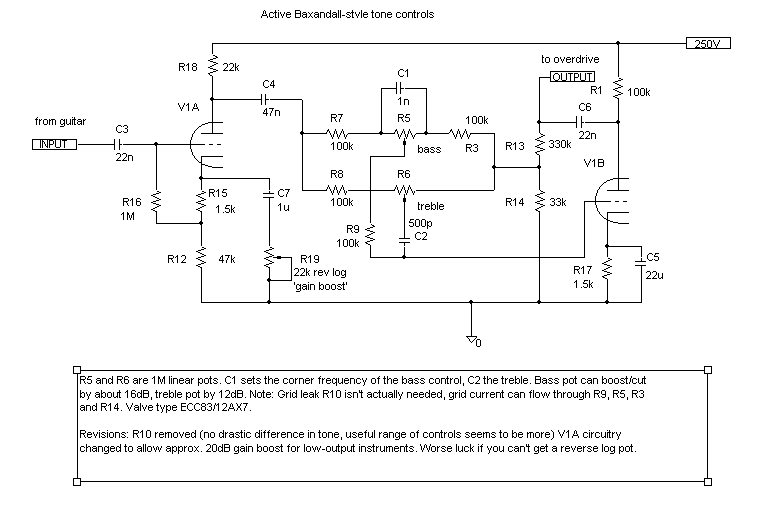
Active Tone controls
Why?
The disadvantages of normal tone stacks are fairly well known. What gets me most is that they can
boost only. I'm a fan of amp designs with two tone stacks, one before the overdrive stage, one after.
In this design the pre EQ has quite a subtle effect. In subjective terms the bass control adjusts the fartiness,
and the treble one adjusts what I can only describe as jangliness. So, if you have a guitar with a fat humbucker in the neck
position you might want to cut the bass right down, reducing fartiness. On the bridge pickup you might
get a better sound with more bass. Jangliness is quite an abstract thing, and purely a personal
preference.
How?
The circuit I developed is an adaptation of one I saw in an op-amp application note. It was originally
a 3-band tone control using an op-amp in inverting mode. I took out the midrange circuitry, scaled all
the impedances up, tweaked the turnover frequencies for guitar use, and swapped the op-amp for a valve.
The circuit has a low-impedance input so I added a buffer.
Update
I was worried that the amp might not work well with low-output guitars. This was always a problem,
so I was stoked when I finally figured out how to solve it. V1A was originally a cathode follower, but
I changed it to have adjustable gain, from 1 and a bit to 10. The tone controls need a low-impedance
drive, I got this by using a small plate load resistor. This reduces the voltage swing but you don't
need it at this point. Don't worry, the valve is not being overloaded.
I also removed V1B's grid leak. I took it out the diagram but forgot to erase the note which mentions it
(it's the mysterious R10)
Using the circuit
Couldn't be easier, the guitar plugs directly into the input, and the
output goes to the overdrive section.
Schematic

e-mail me: "steve at scopeboy dot com"

